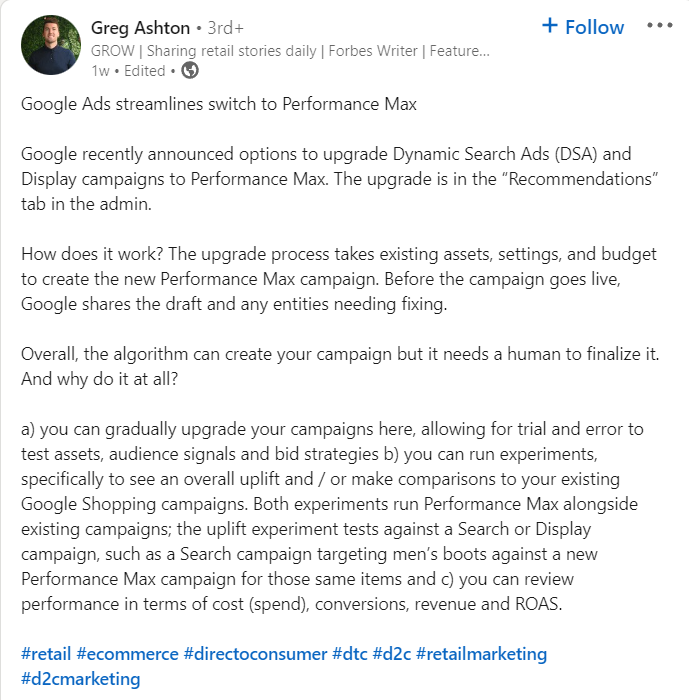Are you looking for ways to boost your online advertising without spending hours on setup? Understanding how Dynamic Search Ads and Performance Max campaigns work can change the game for your business.
These powerful tools help you reach the right customers at the right time, using smart automation that saves you effort and delivers better results. Keep reading to discover how you can use these strategies to make your ads more effective and get more value from every dollar you spend.
Dynamic Search Ads Basics
Dynamic Search Ads (DSA) are a unique type of ad that helps reach customers easily. They work by showing ads based on the content of your website. This means you do not need to list keywords for every product or service.
DSA saves time and finds new customers you might miss with regular ads. The ads change automatically to match what users search for. This way, your ad stays relevant and attracts the right audience.
How Dynamic Search Ads Target
Dynamic Search Ads use your website to find relevant searches. Google scans your site pages and matches queries with your content. Then, it creates ads based on the search term and page content. This targeting method covers many related searches without extra keyword work.
The ads adapt to user searches by showing headlines from your site. This helps connect with users who want exactly what you offer. It also works well for websites with many pages or changing inventory.
Setting Up Dynamic Search Ads
To set up DSA, link your website to your Google Ads account. Choose the pages or categories to target. Write a general description for your ad. Google will then create headlines and landing pages automatically.
Set a budget and select your audience location. Monitor your campaign and adjust bids if needed. This setup process is simple and fast, saving time on keyword research.
Benefits Of Dynamic Search Ads
Dynamic Search Ads help find new customers without building many keywords. They fill gaps in your keyword list and reach more people. The ads update with your website changes, keeping content fresh.
DSA also saves time and effort by automating ad creation. You get better coverage with less work. This makes DSA useful for growing businesses and large websites.

Credit: www.mild.se
Performance Max Essentials
Performance Max is a new Google Ads campaign type. It helps advertisers reach more customers across all Google channels. This includes Search, YouTube, Display, Discover, Gmail, and Maps. Performance Max uses automation and machine learning to show ads to the right people at the right time.
This campaign type is designed to simplify ad management. It combines multiple ad formats and targeting options into one campaign. Advertisers only need to provide creative assets and goals. Google’s system then optimizes the campaign to achieve the best results.
Core Features Of Performance Max
Performance Max uses smart bidding to improve campaign performance. It adjusts bids based on user signals and conversion data. The campaign also uses audience signals to find likely buyers. It supports various ad formats like text, images, and videos.
Another key feature is real-time optimization. The system tests different combinations of assets and placements. It learns which ads perform best and shows them more often. Reporting tools help track which channels and ads drive results.
Campaign Setup Steps
Start by choosing your marketing goal, such as sales or leads. Next, provide creative assets including headlines, descriptions, images, and videos. Add your business details like logo and final URL. Set your budget and bidding strategy based on your goals.
Use audience signals to help Google find potential customers faster. Review your settings and launch the campaign. Monitor performance regularly and add new assets if needed. The system will optimize automatically to improve results.
Advantages Over Traditional Campaigns
Performance Max saves time by managing multiple channels in one place. It uses automation to adjust bids and placements continuously. This leads to better reach and more conversions. It also finds new customer segments that traditional campaigns might miss.
The campaign adapts quickly to changes in user behavior and market trends. This helps maintain steady performance over time. Reporting is clearer, showing how each channel contributes to your goals. Overall, it simplifies ad management while improving efficiency.
Integrating Dynamic Search Ads With Performance Max
Integrating Dynamic Search Ads (DSA) with Performance Max campaigns helps advertisers expand reach and improve results. Both tools use automation but serve different roles. Combining them allows better coverage across Google’s networks. This integration uses data efficiently to target the right customers at the right time.
Combining Strategies For Better Reach
Dynamic Search Ads fill gaps by targeting search queries not covered by keywords. Performance Max runs ads across multiple channels like YouTube, Display, and Search. Using both means capturing a wider audience. DSA finds new queries while Performance Max delivers ads in varied formats. This combination increases visibility and drives more traffic.
Data Sharing Between Platforms
Both DSA and Performance Max share important data like audience signals and conversion tracking. This helps Google’s algorithms learn which ads perform best. Data sharing improves targeting accuracy and bidding strategies. The platforms adapt faster to changes in user behavior. Advertisers get better insights to refine campaigns and save time.
Optimization Tips
Start with clear goals for each campaign type. Use DSAs to cover broad, relevant searches. Let Performance Max focus on multi-channel conversions. Monitor performance regularly to spot overlaps or gaps. Adjust budgets to support high-performing areas. Keep ad copy relevant and landing pages updated. Test different audience signals and creative assets often.
Automation And Machine Learning
Automation and machine learning are key to Dynamic Search Ads and Performance Max campaigns. They help ads reach the right people at the right time. These technologies analyze huge amounts of data fast. They adjust ads based on user behavior and trends. This makes advertising more efficient and effective.
Role Of Ai In Ad Targeting
AI studies user searches, websites, and past actions. It finds patterns that show user intent. This helps ads match what users want. AI targets ads to users likely to buy or act. It reduces wasted ad spend by focusing on interested people. The system updates targeting as user habits change.
Smart Bidding Explained
Smart bidding uses machine learning to set bids automatically. It aims to get the best results for your budget. The system predicts the chance of clicks or conversions. It adjusts bids in real time during auctions. This means higher bids for valuable users and lower for less likely ones. Smart bidding saves time and improves campaign ROI.
Dynamic Creative Optimization
Dynamic creative optimization tests different ad elements automatically. It changes headlines, descriptions, and images to fit the user. The system learns which combinations perform best. Ads become more relevant and engaging over time. This boosts click-through rates and conversions. It also reduces the need for manual updates.
Measuring Success
Measuring success is a key part of running Dynamic Search Ads and Performance Max campaigns. It helps you see what works and what needs change. Tracking the right data shows how your ads perform. It also guides decisions to improve results.
Key Metrics To Track
Focus on clicks, impressions, and click-through rate (CTR). These show how many people see and click your ads. Conversion rate tells how many clicks lead to sales or sign-ups. Cost per conversion helps check if your spending is efficient. Monitor return on ad spend (ROAS) to see profit from ads.
Using Google Ads Insights
Google Ads offers detailed reports and insights. It shows which keywords and audiences bring the best results. Use performance charts to spot trends over time. The insights help understand user behavior and ad impact. Check the recommendations section for easy-to-apply tips.
Adjusting Campaigns Based On Data
Use data to improve your ads regularly. Increase budget for well-performing ads. Pause or tweak ads that do not deliver results. Test new headlines or descriptions to find better options. Adjust targeting to focus on the best audiences. Keep your campaigns fresh and aligned with goals.

Credit: www.datafeedwatch.com
Common Challenges And Solutions
Dynamic Search Ads and Performance Max offer powerful ways to reach customers. Still, advertisers face some common challenges. Understanding these issues helps improve campaign results. Simple solutions can fix many problems quickly.
Handling Low-quality Traffic
Low-quality traffic wastes budget and lowers return. This traffic often comes from irrelevant searches or uninterested users. To reduce it, use negative keywords to block unwanted terms. Adjust targeting settings to focus on your best audience. Monitor performance regularly and pause poor-performing segments.
Dealing With Overlapping Audiences
Overlapping audiences cause ads to compete against each other. This competition can raise costs and reduce clicks. Avoid overlap by organizing campaigns with clear audience segments. Use exclusions to prevent the same user from seeing multiple ads. Check your audience lists often to keep them distinct.
Troubleshooting Performance Issues
Performance issues slow down campaign success. Common problems include low click rates or poor conversions. Start by checking your ad copy and landing pages for relevance. Review your bids and budgets to ensure competitiveness. Use Google’s diagnostic tools to find and fix errors fast.
Future Trends In Search Advertising
Search advertising is changing fast. New tools and methods help advertisers reach the right people more easily. The future holds many changes that will shape how ads appear and perform online. Understanding these trends can help businesses plan better campaigns and get better results.
Evolving Ai Capabilities
Artificial intelligence keeps getting smarter. It can learn user behavior and improve ad targeting. AI helps create more relevant ads by analyzing vast data quickly. This means ads match what people want to see. AI also adjusts bids and placements automatically to get better results.
Increasing Automation
Automation reduces manual work for advertisers. Tools like Dynamic Search Ads and Performance Max use automation to manage campaigns. They handle tasks like keyword selection and budget allocation. This frees up time to focus on strategy and creativity. Automation also makes campaigns faster and more flexible.
Privacy And Data Impact
Privacy rules are stricter today. Users want more control over their data. Advertisers must respect these rules and use data carefully. Less data means less precise targeting. Advertisers use new methods to respect privacy while keeping ads relevant. Transparency and trust are now key in search advertising.
Credit: support.google.com
Frequently Asked Questions
What Are Dynamic Search Ads In Google Ads?
Dynamic Search Ads automatically match your website content to user searches. They help fill gaps in keyword campaigns and attract more relevant traffic. Google generates headlines and landing pages dynamically, saving time and improving ad relevance.
How Does Performance Max Differ From Dynamic Search Ads?
Performance Max campaigns use automation across multiple Google channels. They optimize for conversions using machine learning. Dynamic Search Ads focus mainly on search intent and website content, while Performance Max covers broader ad placements and goals.
Can Dynamic Search Ads Improve Ad Campaign Performance?
Yes, Dynamic Search Ads boost performance by targeting relevant searches. They increase reach without adding keywords manually. This automation helps capture high-intent traffic and improves overall campaign efficiency.
What Benefits Does Performance Max Offer Advertisers?
Performance Max provides comprehensive automation and cross-channel reach. It optimizes bids, creatives, and targeting in real-time. This leads to better conversion rates and efficient budget use across Google’s platforms.
Conclusion
Dynamic Search Ads and Performance Max help reach more customers online. They use smart tools to show ads that fit user searches and interests. This means your ads get seen by the right people at the right time. Both tools save time by automating many tasks.
You can test them to see which works best for your business. Start small, watch your results, and adjust as needed. These ad types make advertising easier and more effective for many businesses. Give them a try to improve your online presence.

